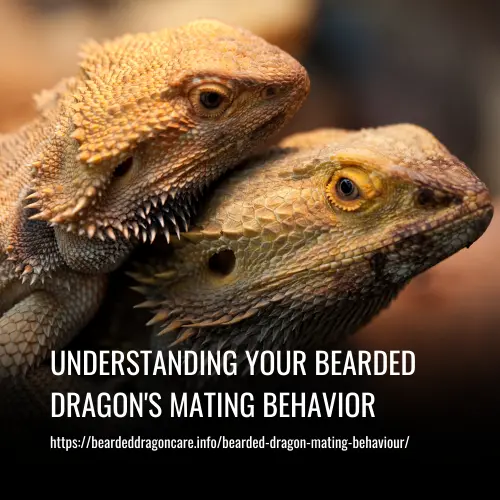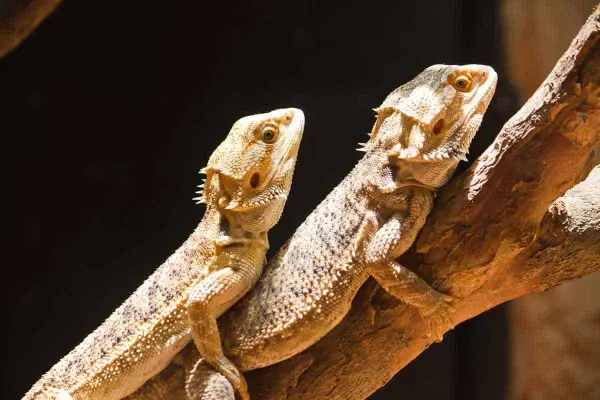Bearded dragons are calm and docile creatures, but during the breeding season, they can change into little aggressive breeding monsters. During this time, Bearded dragons will show the typical, what looks like aggressive, mating behavior towards their mates and keepers.

Bearded dragon mating behaviour
During the mating season, a breeding pair will show much more interest in each other, especially the male towards females. Mating behaviour is typically characterized by the male on top of his female counterpart, biting her neck and beard to hold on for copulation. Their tails will be intertwined to allow the reproductive organs to meet. Also, see Bearded dragon breeding for more information.
The breeding season will also go with a lot of head bobbing movements, and some form of hostility towards other Bearded dragons, humans, and even live food. Behaviours like the opening of the mouth and the darkening, to a black to gun metal black color, of the beard and large parts of the body are frequently seen.
Male Bearded dragon showing off his large, black beard.
A frequent consequence of mating behavior is bite marks in the neck and mouth area of mating females. Some couples might also refuse to eat and lose weight during this period.
Female Bearded dragon with bite marks on her lips & beard because of aggressive mating behaviour.
Bearded dragon mating
The mating process of Bearded dragons is vigorous. Courtship involves mounting and holding on by the male. Bite marks are usually visible on the dorsal head, beard, lips, and front legs of adult females during the breeding season. Flapping of the forelegs by the male may occur while holding the female. To signal the male to release the female will lift her head into an almost vertical position.
Bearded Dragon Mating Rituals
Mating rituals for Bearded Dragons are quite unique. They express their willingness and capability of mating and producing a viable next generation through several forms of body language.
Male Mating Behaviors
If you’ve ever been lucky enough to observe the mating rituals of a group of bearded dragons, then you know that this is an incredible sight!
- Males will often employ three main behaviors in order to signal their readiness to mate:
stomping, puffing up, and darkening their beards and head-bobbing. - Stomping displays physical strength as they stamp their feet – it can form into patterns or be completely random to draw a female’s attention.
- Puffing up the beard displays sexual maturity and shows that he is old enough to provide viable offspring.
- Finally, head-bobbing demonstrates dominance over others and can be directed toward other males as a sign of competition and bullying.
All these elegant yet intimidating behaviors usually occur together. When males see their reflection in the absence of other dragons around them, they may bob their heads as if to intimidate themselves.
Female Mating Behaviors
Bearded Dragons have their own unique mating rituals which involve the male and female displaying different behaviors towards each other.
- If a female is receptive to a male’s behavior, she will bob her head in return and wave her arms at him.
- Unless she is calm, she will attempt to flee or could even hurt herself if she can’t get out of the area.
- It’s also important to note that gaping (opening of their mouths) is not a mating behavior but rather done by dragons to regulate their body temperature;
- if both sexes are observed with mouths open staring at each other, they’re likely trying to cool down.
- For successful mating, all enclosure settings need to be checked since an incorrect setting such as temperature or humidity can be the problem.
By understanding dragon behavior during the mating process, we can ensure that our pet bearded dragons reproduce successfully!
How Do I Know If My Bearded Dragons Are Mating?
When it comes to determining if your bearded dragons are mating, there are certain behaviors you should be on the lookout for. The male bearded dragon will approach the female and start bobbing his head up and down in a circle around her. His beard may also become darker than usual during this display of courtship.
The female may then respond by flapping her arm, as well as bobbing her own head. This means they are mutually ready to mate. The male will then mount the female, holding her still with a bite to her shoulder or neck area.
Occasionally, he might accidentally tear the female’s skin during this process.
Afterward, their cloacae come together, allowing the male to insert one or both of his hemipenes (sexual organs) into the female’s cloaca.
At this point, sperm is released in order for fertilization of eggs to take place and when it has finished, you’ll notice that the female raises her head – signaling that mating is complete between them.
How Long Does It Take For Bearded Dragons To Mate?
Bearded dragon mating will happen with a little prodding on your part. If two sexually mature adult bearded dragons are placed in the same enclosure, it won’t be long before they begin to mate.
The actual act of mating only lasts for a few minutes and it is wise to keep them together for at least another week afterward in case they repeated the activity or if the first attempt was unsuccessful.
After this period, you should separate the male and female dragons as leaving them together can cause injury to the female through the over-aggressive behavior of the male.
If you believe the mating has failed, you may try again after separating them for a time but never leave a male and female bearded dragon together any longer than a week.
When Do Barded Dragons Mate?
Bearded dragons are naturally ready to mate in the spring, in their native environment. This is when they awaken from their period of brumation and enter a mating season that runs through early summer.
In captivity, some beardies may not go through this process; however, allowing them to brumate can increase their fertility.
To mate successfully, both the male and female must be sexually mature – this usually occurs at 8 months of age for males and 24 months for females.
However, it’s best to wait until the male is 18 months old and the female 24 months old before attempting to breed with them. After 3 or 4 years of age, the female’s fertility begins to drop off.
Therefore, when breeding bearded dragons, try to replicate the cycle as closely as possible by giving them time to brumate during winter and only allowing a male and female together during mating season. Doing so will ensure you get great results!

How Often Do Bearded Dragons Mate?
Bearded dragons typically mate once or may even mate multiple times until fertilization takes place. If you are wanting to breed them, you should let the male and female together for a week after mating has occurred, remove her for a week, and then put them back together for another week.
This will increase the chances of successful fertilization without putting any risk to the female’s health.
A female bearded dragon that is sexually mature and healthy should produce between 4-6 clutches of eggs each year. In order to produce an optimal number of clutches, it depends on factors such as a stress-free environment; a balanced diet; and proper calcium supplementation.
After the successful mating has taken place, the female typically lays eggs around 4-6 weeks later. To maximize the success rate in hatching these eggs, they normally take 50-100 days (or even longer).
It is important to note that a single mating can actually fertilize two clutches or possibly more if sperm is stored inside of her body!
How Do You Know When A Mating Is Successful?
Knowing when a mating between two bearded dragons is successful can be tricky. The only real way to know is by looking out for signs that the female has become gravid, or pregnant.
This can include her gaining weight and having a swollen abdomen, or the appearance of marble-like protrusions, which are actually her eggs sticking out of the side of her abdomen.
It is also important to consider the timing when it comes to mating two bearded dragons, as fertility plays an important part in this process.
A female may go off her food if the space taken up by the eggs within her abdomen compresses the stomach, as well as becoming restless and digging a hollow in which to lay them.
Nevertheless, watching out for these signs will help you determine whether or not your dragon’s mating was successful.
FAQs
How Do You Know If Your Bearded Dragon Wants To Mate?
If you want to know if your bearded dragon is ready and interested in mating, keep an eye on their behavior. Males will become increasingly aggressive, possessive, and dominant. In fact, their beard might even darken in color!
Female bearded dragons will start digging obsessively and may become more erratic in their actions; they might also put on some extra weight.
With these behavioral signs, you’ll be able to determine if your bearded dragons are ready for a mating session or not!
How Long After Mating Does A Bearded Dragon Lay Eggs?
After a successful mating, female bearded dragons will begin laying eggs between four and six weeks later. This usually marks the start of egg-laying, but a female can continue to lay eggs even after that amount of time has passed due to stored fertilized eggs from the same mating session.
So if you want to find out how long after mating does a bearded dragon lay eggs, the answer is anywhere from four weeks up to several weeks later. That’s because they can keep laying eggs beyond that initial period if given enough time!
Conclusion:
Bearded dragons are fascinating creatures that display complex mating behavior. By understanding and properly monitoring your dragon’s mating behaviors, you can ensure their health and happiness.
Overall, watching a bearded dragon during the mating process is both amazing and educational. With proper maintenance, patience, and knowledge about them, you will be able to create an ideal environment for your pet so they can thrive and enjoy the experience of life in captivity.
